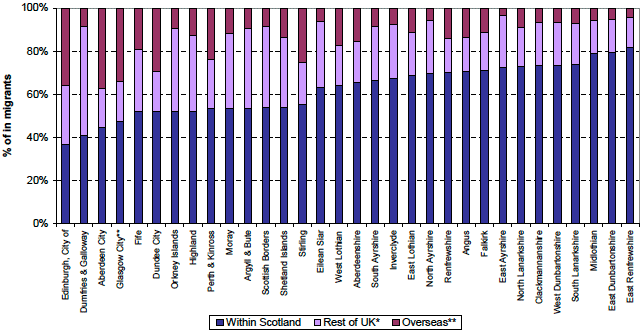
4.1 Population change mid-2010 to mid-2011
4.1.1 Population estimates for each Council and NHS Board area, together with details of the components of population change (births, deaths, net migration and other changes) for the period mid-2010 to mid-2011, are shown in Table 2, Table 3 and Table 4.
4.1.2 Among Council areas, City of Edinburgh had the largest percentage population increase at +1.9 per cent followed by Aberdeen City and Midlothian (both +1.5 per cent), and Perth & Kinross (+1.2 per cent). Eight Council areas experienced a decrease in population although the decreases were very small for three Council areas. Larger decreases were experienced in Inverclyde (-0.7 per cent), Moray (-0.5 per cent), Eilean Siar (-0.4 per cent), West Dunbartonshire (-0.2 per cent) and Dumfries & Galloway (-0.1 per cent).
4.1.3 Of NHS Board areas, Lothian had the largest percentage population increase (+1.4 per cent), followed by Grampian (+0.9 per cent) and Tayside (+0.8 per cent). The only NHS Board areas to have experienced a decline in population were Western Isles (-0.4 per cent) and Dumfries & Galloway (-0.1 per cent).
4.2 Components of migration mid-2010 to mid-2011
4.2.1 For most areas, the main cause of population change in the year to mid-2011 was migration. Table 5 shows migration flows to and from each Council and NHS Board area for people moving within Scotland (i.e. between one Council area and another or between one NHS Board area and another), people moving between Scotland and the rest of the UK and people moving between Scotland and overseas. In Table 5 and in Figure 5a and Figure 5b, movements to and from the armed forces are included in the rest of UK figures.
4.3.1 As Figure 5a shows, different Council areas attract migrants from different areas. In some Council areas (such as East Renfrewshire, East Dunbartonshire and Midlothian) most of the migrants came from other Council areas within Scotland. For example, of the 3,196 people estimated to have arrived in East Renfrewshire, 2,617 (about 82 per cent) were from elsewhere in Scotland, 443 (about 14 per cent) from the rest of the UK and 136 (about 4 per cent) were from overseas.
Figure 5a: Origin of in-migrants by Council areas, mid-2010 to mid-2011 (ranked by increasing percentage of migrants from within Scotland)

* Includes moves from the armed forces
** Includes asylum seekers
4.3.2 In other areas (such as Dumfries & Galloway) more than half of the migrants entering the area came from outside Scotland with most of these coming from the rest of the UK.
4.3.3 In City of Edinburgh, Glasgow City and Aberdeen City, the pattern was of high proportions of migrants coming from outside Scotland but for these areas most migrants came from overseas.
4.3.4 As Figure 5b shows, there are also differences in the destinations of people migrating out of Council areas. Often the region to which most out-migrants moved was the same region from which most in-migrants had arrived. For example most of the migrants leaving East Renfrewshire, East Dunbartonshire and Midlothian moved elsewhere in Scotland and, as already described, most of the migrants arriving in these Council areas came from elsewhere in Scotland.
Figure 5b: Destination of out-migrants by Council areas, mid-2010 to mid-2011 (ranked by increasing percentage of migrants to within Scotland)
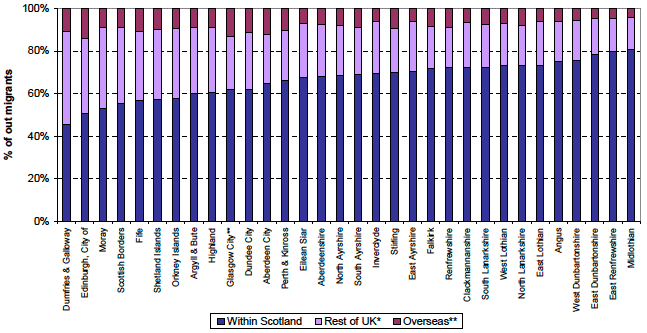
* Includes moves to the armed forces
** Includes asylum seekers returning to their country
4.4.1 As Table 5 shows, some Council areas experienced net gains from one region but net losses to another whilst others experienced gains from all of the regions (within Scotland, the rest of the UK and overseas).
4.4.2 East Ayrshire experienced net losses of people to all regions, while East Lothian, Falkirk, Midlothian and Scottish Borders were among those to have a net gain of people from all regions.
4.4.3 The larger city authorities tended to lose migrants to other areas of Scotland but gain from overseas. For example, there was a net gain of 7,491 migrants in City of Edinburgh - comprising a net loss of 336 people to the rest of Scotland and net gains of 236 people from the rest of the UK and 7,591 people from overseas.
4.5 Population change mid-2001 to mid-2011
4.5.1 Details of population changes in administrative areas between 2001 and 2011 are shown in Table 6. These changes are illustrated for Council areas in the map at Figure 6a and the chart at Figure 6b which both show the percentage change in the population of Council areas between 2001 and 2011.
Figure 6a: Percentage change in population, Council areas, mid-2001 to mid-2011 (Map)
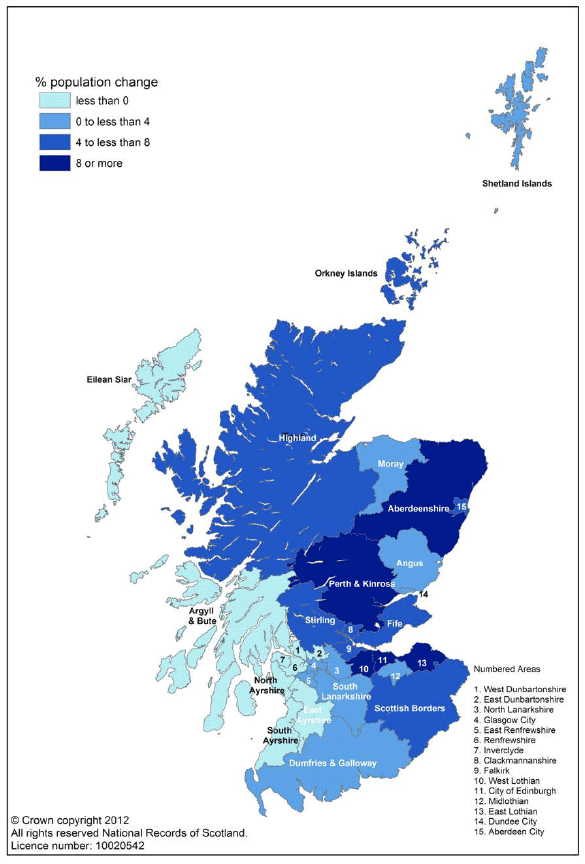
Figure 6b: Percentage change in population, Council areas, mid-2001 to mid-2011 (Chart)
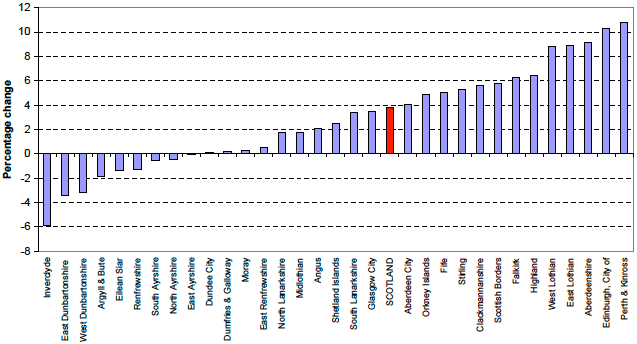
4.5.2 Between 2001 and 2011, the Council areas with the largest percentage population growth were Perth & Kinross (+10.8 per cent), City of Edinburgh (+10.3 per cent) and Aberdeenshire (+9.1 per cent). The largest absolute increase in numbers was in City of Edinburgh (+46,340). Inverclyde (-5.9 per cent), East Dunbartonshire (-3.4 per cent) and West Dunbartonshire (-3.2 per cent) showed the greatest percentage decreases during this period. The largest absolute decrease in numbers was in Inverclyde (-4,930).
4.5.3 The map at Figure 7a and the chart at Figure 7b show the percentage change in population between 2001 and 2011 for each NHS Board area. The largest percentage increases in population were in Lothian (+9.0 per cent), Borders (+5.8 per cent) and Forth Valley (+5.8 per cent). The only areas to experience percentage decreases were Western Isles (-1.4 per cent) and Ayrshire & Arran (-0.4 per cent).
Figure 7a: Percentage change in population, NHS Board areas, mid-2001 mid-2011 (Map)
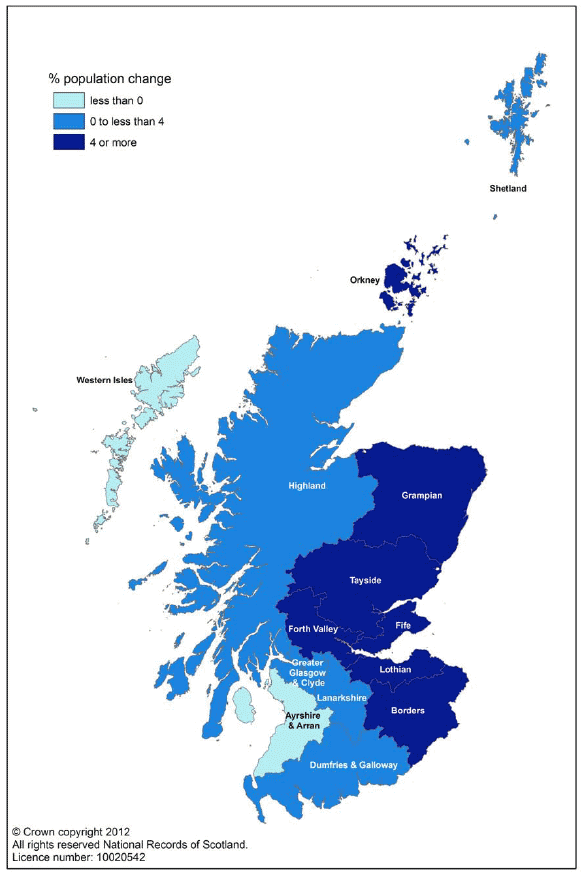
Figure 7b: Percentage change in population, NHS Board areas, mid-2001 mid-2011 (Chart)
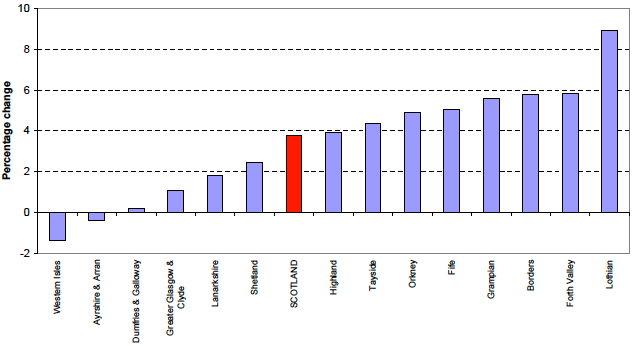
4.6 Age and sex structure of administrative areas in Scotland
4.6.1 There were more women than men in Scotland in mid-2011. This was the case for all Council areas other than Moray and Shetland Islands and for all NHS Board areas other than Shetland. Table 7 shows the sex ratio for each Council and NHS Board area in Scotland. The sex ratio is the male population divided by the female population (e.g. a sex ratio of 0.95 means that for every 100 females there are 95 males). The sex ratio ranged from 0.90 in North Ayrshire to 1.03 in Shetland Islands. For the NHS Board areas, the sex ratio ranged from 0.92 in Ayrshire & Arran to 1.03 in Shetland.
4.6.2 Although the pattern of age distribution is complex, some general themes can be seen from Table 7. Most city Council areas had a high proportion of men and women of working age. For example, in City of Edinburgh 72 per cent of men and 65 per cent of women were of working age compared with 67 per cent of men and 59 per cent of women for all of Scotland. The highest proportions of people of pensionable age tended to be in more rural areas such as Dumfries & Galloway (21 per cent of men and 31 per cent of women) and Argyll & Bute (20 per cent of men and 31 per cent of women). In Scotland as a whole, 15 per cent of men and 24 per cent of women were of pensionable age.
4.6.3 These patterns can also be seen in Figure 8 and Figure 9 which show the proportion of the population aged under 16, 16-64, and 65 and over for Council and NHS Board areas respectively (ranked by the proportion of population aged 65 and over).
Figure 8: Age structure of Council areas, mid-2011 (ranked by percentage aged 65+)
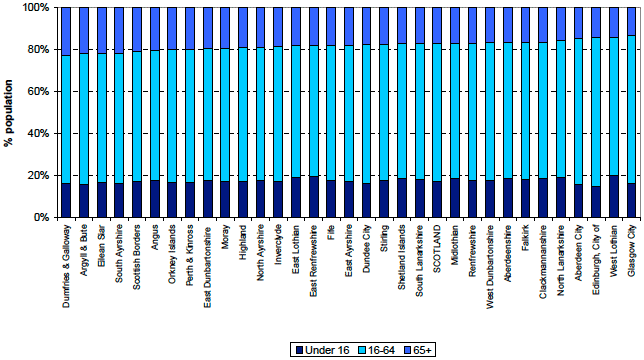
Figure 9: Age structure of NHS Board areas, mid-2011 (ranked by percentage aged 65+)
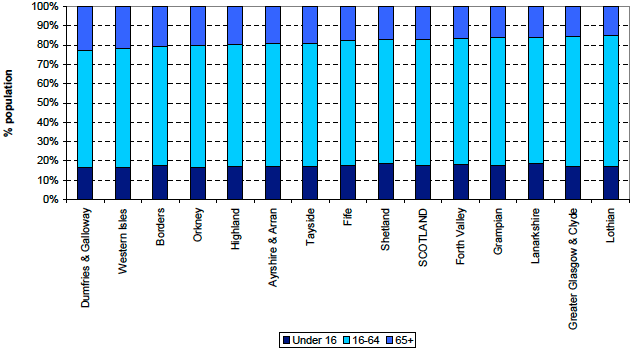
4.7.1 Information on land areas and population densities is shown in Table 9. The mid-2011 population density was 67 persons per square kilometre for Scotland and ranged from 8 people per square kilometre in Eilean Siar to 3,412 people per square kilometre in Glasgow City.